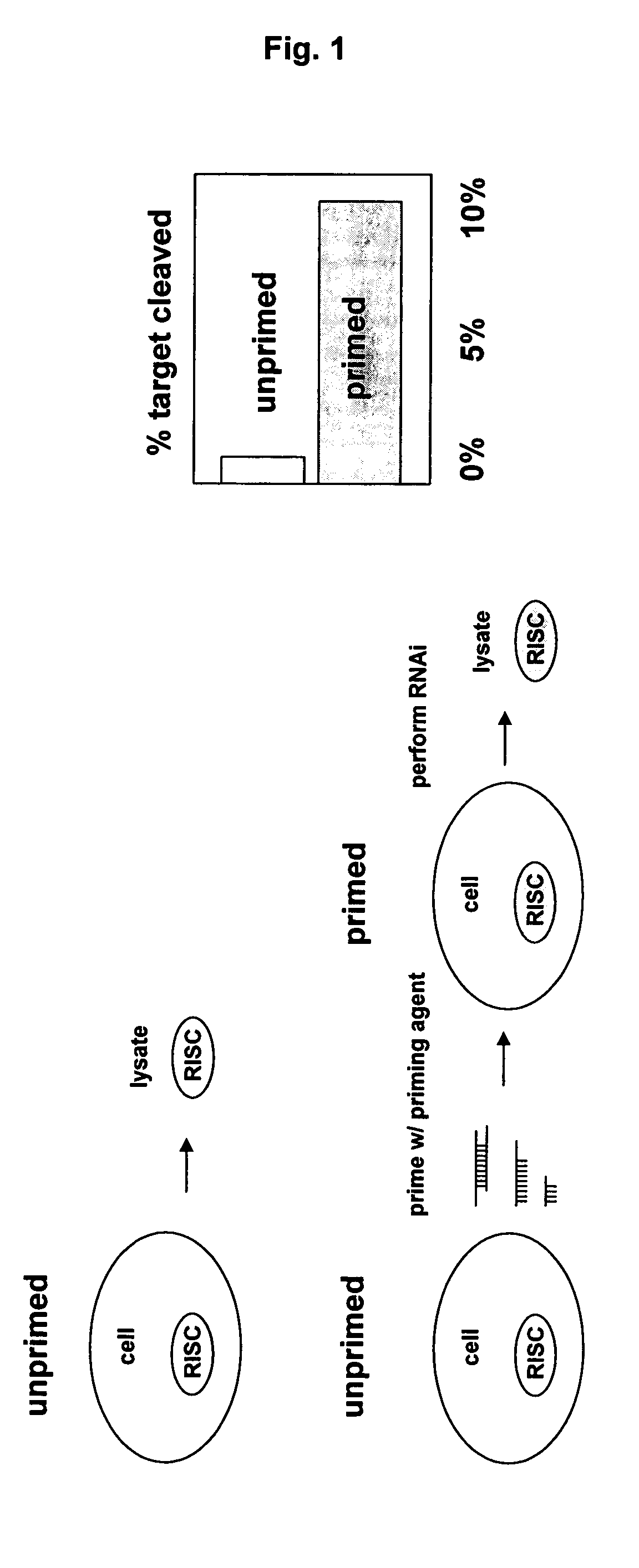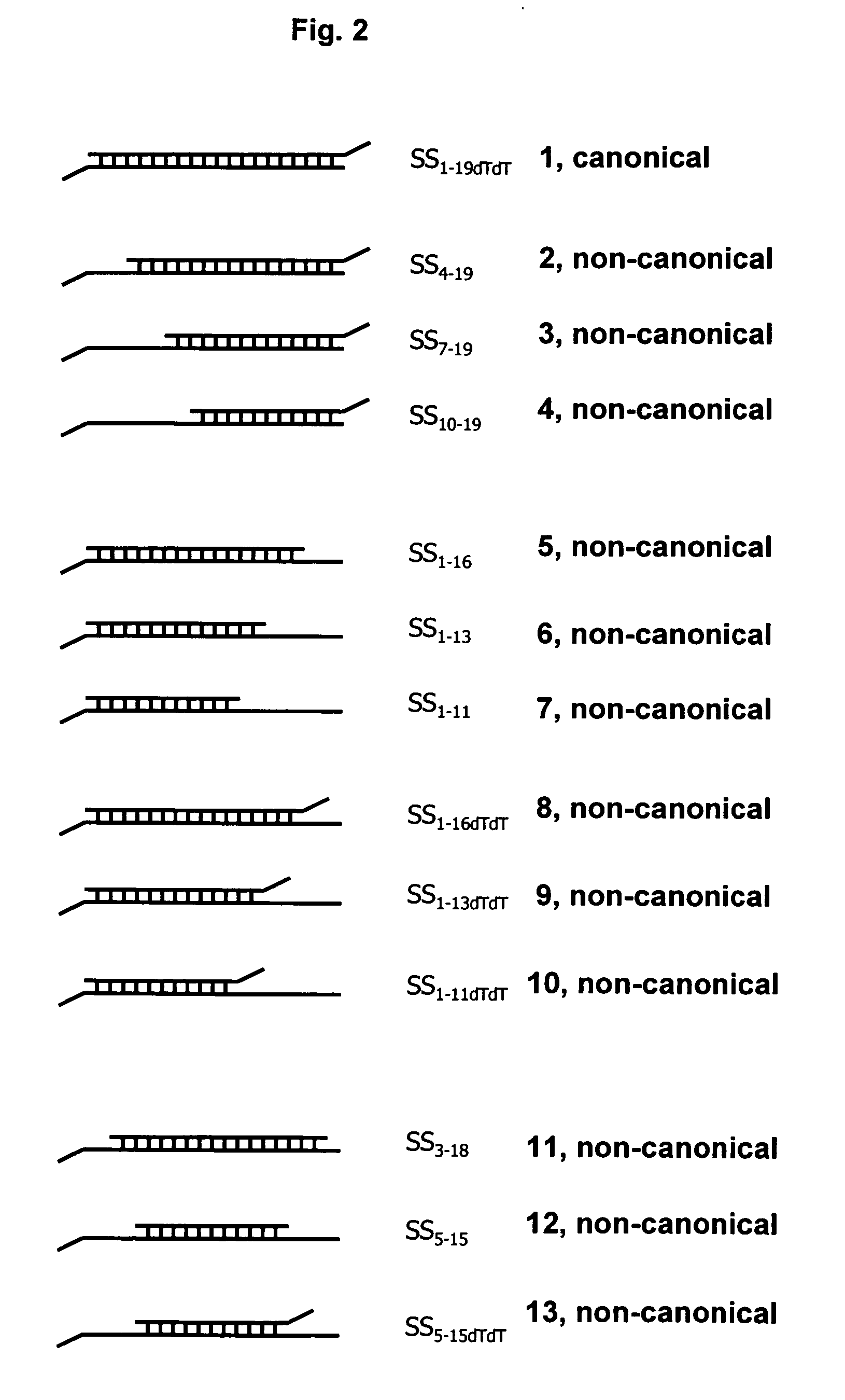Methods and compositions for enhancing RISC activity in vitro and in vivo
- Summary
- Abstract
- Description
- Claims
- Application Information
AI Technical Summary
Benefits of technology
Problems solved by technology
Method used
Image
Examples
example 1
In Vitro Methods for Activating RISC in Mammalian Cells
[0116] The following example describes methods for activating RISC activity in mammalian cells by first treating the cells with a priming agent whereby the resultant cells and extracts that can be derived therefrom, are substantially improved for carrying out RNAi on a given target gene.
[0117] Briefly, cells were transfected with a nucleic acid priming agent as described above. Cells or cell extracts where then isolated / prepared alongside appropriate controls and challenged in an siRNA-mediated cleavage assay (as described above) to determine the level of RISC activity in the primed versus unprimed cells / extracts as a function of specific gene target degradation. Unprimed human HeLa cell extracts where determined to have only 0.1-1.0% gene target cleavage activity whereas primed HeLa cell extracts were determined to have 10% or more gene target cleavage activity (see FIG. 1).
[0118] Accordingly, these results indicate that pri...
example 2
In Vivo Methods for Activating Risc in a Mammal
[0119] The following example describes methods for activating RISC activity in a whole organism by first exposing the organism to a priming agent whereby the organism is more responsive to RNAi / gene silencing techniques.
[0120] Briefly, a model organism is chosen and exposed to a priming agent. Preferably, the organism is a mouse which has been transgenically altered to express a priming agent, the priming agent being in the form of, e.g., an expressible nucleic acid, e.g., an shRNA, and expressed conditionally and / or tissue specifically using appropriate conditional / tissue specific promoters. Such an in vivo expression arrangement of the priming agent allows for the temporally priming of a particular tissue. Accordingly, only those cells in need of being targeted for RNAi / gene silencing will be primed and responsive. An RNAi / gene silencing agent is then administered, e.g., an siRNA specific for a gene target in need of knock-down is a...
example 3
High Throughput Screening Assays Using Activated Mammalian RISC
[0122] The following example describes methods for conducting high throughput screens for gene activities in mammalian cells using RNA interference whereby the cells (or extracts) are first primed for high levels of RISC and therefore, RNAi responsiveness.
[0123] Understanding the consequences of complex gene activities in mammalian cells is highly desirable. Previously, mammalian cells have had low responsiveness to RNAi techniques. Accordingly, mammalian cells, for example, human cells, e.g., HeLa cells are first primed using the priming agents of the invention. The primed cells (or extracts thereof) now contain high levels of RISC activity and therefore are responsive to RNAi.
[0124] To determine if the mammalian cells have been appropriately primed and are now responsive to RNAi / gene silencing techniques, the dual fluorescence efficacy assay described above can be employed. Briefly, the cells having a fluorescent GF...
PUM
| Property | Measurement | Unit |
|---|---|---|
| Interference | aaaaa | aaaaa |
Abstract
Description
Claims
Application Information
 Login to View More
Login to View More - R&D
- Intellectual Property
- Life Sciences
- Materials
- Tech Scout
- Unparalleled Data Quality
- Higher Quality Content
- 60% Fewer Hallucinations
Browse by: Latest US Patents, China's latest patents, Technical Efficacy Thesaurus, Application Domain, Technology Topic, Popular Technical Reports.
© 2025 PatSnap. All rights reserved.Legal|Privacy policy|Modern Slavery Act Transparency Statement|Sitemap|About US| Contact US: help@patsnap.com


